New Personal Best
Jamie Nieto is using the training principles that got him to the Olympics to beat paralysis—and they’re working.
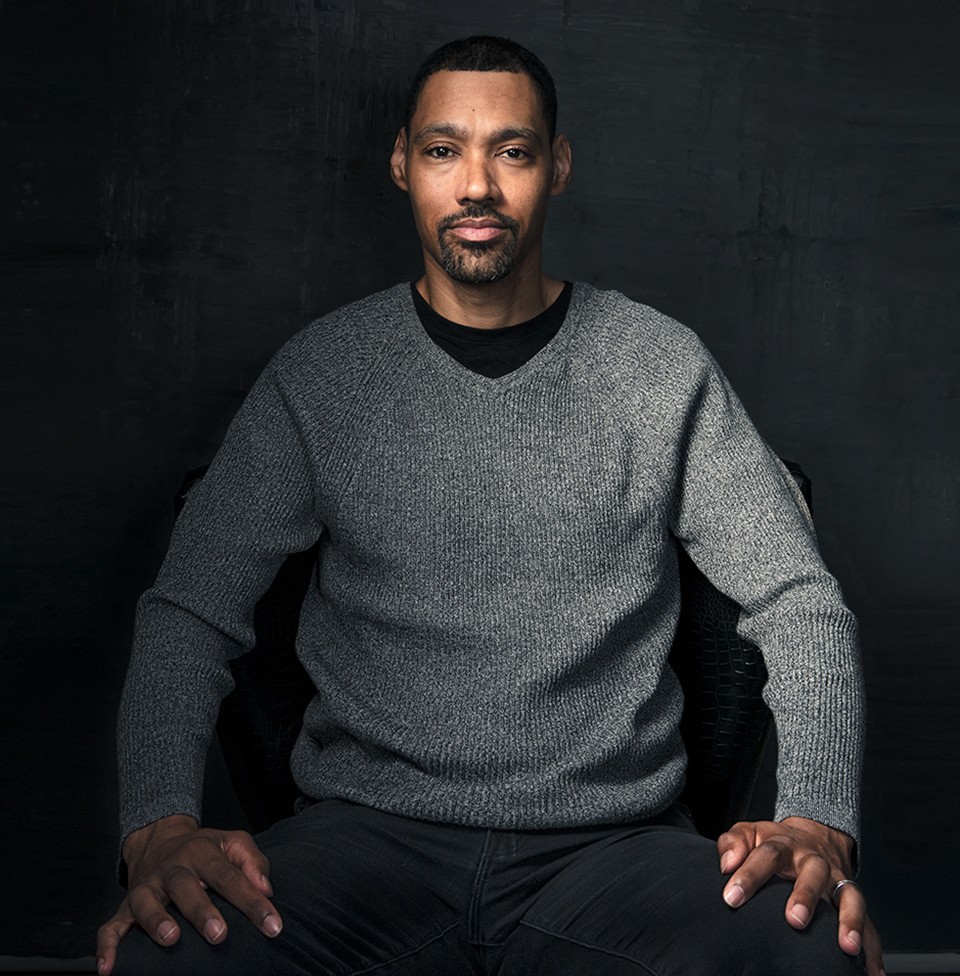
It’s been said that the average human touches their face 2,000 times a day.
“There are so many things that we do on a normal basis that we take for granted and we don’t even realize,” says Jamie Nieto (BBA99).
After a freak accident in 2016 left the two-time Olympic high jumper partially paralyzed from a spinal cord injury, “I had to have somebody scratch my face for me because I couldn’t move my arms.”
He also had to learn to eat again, starting off with pureed food and gradually working his way back to solid food. He had to learn how to breathe more effectively after the surgery to repair two discs that impacted his diaphragm. And three years after his accident, he’s still learning to walk again.
Having found success—and disappointment—in a sport measured in inches, Nieto understands better than most the challenge of willing one’s body to realize its fullest potential.
“As time has gone on, I’m just getting better and better,” he says at the Pasadena, Calif., apartment that he shares with his wife, Jamaican Olympic hurdler Shevon Stoddart. “I didn’t become an Olympian overnight. It took time for me to develop. I started in 1993 as a junior in high school and I didn’t make my first national team until 2003. And then the next year, 2004, I made the Olympic team.”
Nieto hopes it won’t take another 11 years to fully restore his body so that he can run again, but “I’ve got the rest of my life to get better,” he says, “and I’m going to do my best to get better as fast as I can.”
Friends often tell Nieto that his story is inspirational—which it truly is. “But I don’t want to be inspirational,” he says, no trace of bitterness in his voice. “I don’t want to be motivational. I want to have a normal life. I want to be able to do what I used to do. That’s where I want it to be, but if these are the cards I’ve been dealt, I’m going to play them.”
•••
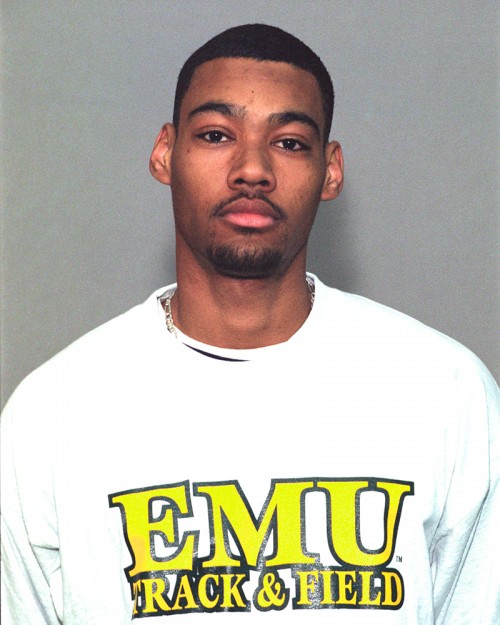
Nieto discovered his love for track and field as a junior at Valley High School in his native Sacramento, Calif., after a bad grade in geometry class kept him off the basketball team his junior year. “I was kind of discouraged because I wanted to do a sport, but I didn’t know what to do,” he recalls. A friend suggested that he try track and field: “You can do the high jump and you can come back next year for basketball and you’ll be dunking on everybody, you know?’” That first year, he “pretty much jumped over my head at that time—6’4”, which was the goal”—and made it to the high school state meet in California.
As a senior, Nieto returned to the basketball team, but his focus had shifted to track and field. He ended up jumping 6’9” and got into the state meet again. His jump wasn’t high enough to attract a full scholarship from a Division 1 college, so he enrolled at Sacramento City College. Eventually he jumped over 7’, and several D1 colleges took notice. One of them was Eastern Michigan, where Coach Bob Parks was looking for a second high jumper to shore up his roster. “I talked to the coaches out there and they said, ‘We’d love to have you and you would start competing right away,’” Nieto recalls. “That sounded appealing to me, so that’s what I did. I didn’t have a recruiting trip or anything. I had never even seen the campus—I just went.”
Eastern Michigan has sent at least one track competitor to every Summer Olympics since 1960. Nieto kept that streak alive in 2004, as the school’s sole representative in Athens, Greece, and returned in 2012, alongside Eric Alejandro (BBA08) representing Puerto Rico in the 400-meter hurdles.
“It wasn’t until I was at Eastern Michigan that I really developed that dream to think that I could make an Olympic team,” Nieto says. During his first season at Eastern, after he failed to qualify for the NCAA meet, he made a promise to his coach, Brad Fairchild: “Next year, I’m going to become an All-American. I’m going to break the indoor and outdoor school record.”
How did he get better as a high jumper? “Practice, hard work, dedication, prayer—all of that.” At his first meet, Nieto jumped 7’1”, a new personal best. At the next meet, he jumped 7’3”, which broke the school record and qualified him for the NCAA meet. “All the things that I told the coach I was going to do, I ended up doing.”
•••
At his first Olympic Trials in 2000, Nieto missed the cut, finishing fifth in the high jump. His preparation wasn’t as good as it could have been, he says, and later that year he moved to San Diego, where he could work out at the Olympic Training Center in nearby Chula Vista.
In July 2004, Nieto won a spot on the U.S. track and field team in front of a hometown crowd at the Olympic Trials in Sacramento. “That was one of the highlights of my career,” he says. “To make the Olympic team in front of my friends and family was just an amazing experience.” Less than one month later, he was walking with his U.S. teammates during the opening ceremony in Athens. “The energy there was electrifying.”
That electricity carried over into the high jump competition, where Nieto cleared 7’8” on his fourth attempt—a personal best, putting him in a three-way tie for second. But determining who medals comes down to misses—and fellow American Matt Hemingway and the Czech Republic’s Jaroslav Bába cleared 7’8” on their first attempt, dropping Nieto down to a “bittersweet” fourth.
Following “a little post-Olympic depression” in the aftermath of the 2004 games, Nieto began to show “sparks of life” in 2007. Working with coach Cliff Rovelto of Kansas State University, he took second place in the high jump at the USA Outdoor Championships that year. “I was getting excited and my jumping was getting better,” he says.
His dreams of making the 2008 Olympic team were derailed, however, following a rule change by USA Track & Field, the governing body of the sport. Nieto lost his appeal in arbitration, and was forced to sit out the Beijing games. “I feel like I fought a great battle, but I ended up not winning,” he says. “It was upsetting.”
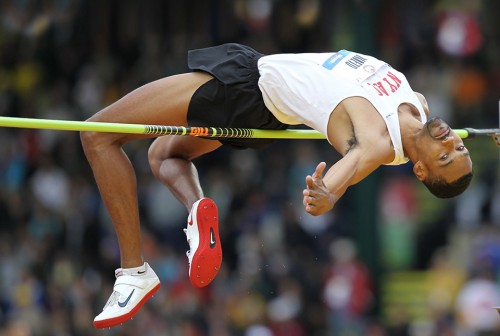
By 2012, the Olympic “A” Standard for high jumpers went up to 7’7”—a measure Nieto hadn’t cleared in years. “I needed to change the way I was thinking about competing,” he says. At every one of his 13 meets that year, Nieto aimed for the “A” Standard. “At some meets, I was kind of close,” he says. “At some meets, I wasn’t close at all.” Going into the 13th meet in New York, he thought, “Today is going to be the day that I do it.’”
Nieto cleared 7’2” with no problem, and passed 7’4”, 7’5”, and 7’6” in short order. If he cleared 7’7”, his odds of making the Olympic team “went from 50 percent to about 90 percent in my mind.” He cleared it on his first attempt. “The weight was off my shoulders.”
On the second day of the Olympic Trials, Nieto cleared 7’5” on his first attempt. “Everybody else missed and I was kind of in the driver’s seat,” he says. When the bar was raised to 7’7”, Nieto missed all three of his attempts and worried he might be out of it. But as the day wore on and fatigue set in, all of his competitors—some of them 10 or 12 years his junior—came up short as well, and Nieto won the Olympic Trials at age 35.
After making his second Olympic team, “I just started crying and praying,” he recalls. “I tell people all the time that I have more down times in track and field than up times. But those up times made everything worth it.”
At the Olympic Games in London, Nieto again jumped the same height (7’6”) that was good enough for bronze, but missed out on a medal because of a tie-breaker. But his response in London was a world away from Athens. “Afterward, an interviewer said to me, ‘You’re the happiest person who didn’t get a medal. Why?’ At that point in time, I was so happy just to be able to be there and compete and do this again. I knew I did the best that I could do that day, so I felt like I won no matter what.”
The 2012 Olympics would be his last as a competitor. A fractured foot following the Games necessitated surgery, so Nieto took off most of 2013 from training and began working with a promising long jumper as a coach. “It was a natural progression to go into coaching after track and field. But I knew that I wanted to get into acting, writing, and producing—and coaching would be my side thing until that took off.”
In addition to shopping around Blood Brothers (a crime drama he wrote, produced and stars in), he found work at Harvest Studios with producer-director Bentley Kyle Evans, former show runner for Martin and The Jamie Foxx Show, on the Bounce TV series Family Time and In the Cut. He sold his first script in 2016 and has been writing for Harvest ever since.
•••
On Friday, April 22, 2016, Nieto had made his way from the set of Family Time to Azusa Pacific University’s Cougar Athletic Stadium, where he was working with four Olympic high-jump hopefuls. “I had been talking to a friend of mine and telling him I can still do a back flip”—his signature move after big events—“and he was like, ‘Naw, man, you can’t.’
“That day we were at the track warming up, and starting to do some drills and stuff. And I said, ‘Oh, you know? Let me do this back flip real quick and videotape it so I can show my friend I can still do it.’ So, I did one, and it was pretty good. And then I did a second one and I felt like I could push up a little bit higher because it’ll make it a little bit cleaner. And then the third one that I did, I pushed up and one of my feet slipped and I kind of went split leg in the air,” he says. “And when I hit the ground, I couldn’t move.”
Nieto was medevacked to a hospital, where doctors determined that the disc in his neck had slipped back, bruising the spinal cord and leaving him paralyzed from the chest down. He underwent surgery within six hours of the accident to move his disc back into place and fuse his C3 and C4 discs together.
At the time, doctors told his then-girlfriend, Stoddart, that they thought Nieto would regain about 30 percent functionality. “I don’t know what that is—maybe feeding myself—but it’s not walking,” Nieto says. He told the doctors that he was going to make a full recovery: “I feel like God just told me that and that’s what’s going to happen. So, I appreciate your diagnosis, but we’re going to be all right.”
Nieto spent about two weeks in ICU before being transferred to a nearby rehabilitation facility. “After three days in bed, your muscles start to atrophy,” he says. “Nothing was moving from my chest down. I could barely shrug my shoulders. Every morning I would wake up and I would visualize myself opening and closing my hand—I would do it in sets of 100.”
After nearly two weeks at the rehab center, the occupational therapist was working with his fingers when one them barely twitched. “I was like, ‘Oh my God, it’s moving!’ And then my toes started moving a little bit,” Nieto says. “That day, I ended up moving seven out of my 10 fingers—and by the end of the week, I was moving all 10 fingers, which was great. They told me at the rehabilitation center that if it can move, then it has an opportunity to get stronger and better.”
•••
Nieto’s rock through his hardest moments, including two months at the rehab facility, was Stoddart, whom he met at a commercial audition in 2010. “I think it was for a new Samsung flat-screen, 3-D TV and they wanted the athletes to look like they were jumping out of the TV,” he recalls. “I was high jumping and she was hurdling.” (She booked the job—he didn’t.)
The two reconnected in 2012 when Stoddart responded to Nieto’s Facebook pitch to support a crowdfunding campaign toward postproduction of Blood Brothers. The two crossed paths soon after at a series of track meets—and they finally went out on a lunch date after a meet at UCLA. “We’ve been together ever since,” Nieto says.
In October 2016, the couple was in a jewelry store, having picked out an engagement ring before actually getting engaged. “I was still in a power wheelchair at the time,” he says, and when they went to pick up the ring, Nieto turned to Stoddart in the store and said, “Hey, will you marry me?” Stoddart said, “Yes.”
At that point, six months after his injury, Nieto decided on a “new Olympic goal”: walking his bride down the aisle that following July. Stoddart estimated that it would take about 150 steps to get out of the church—and Nieto was taking no more than three steps at a time before falling.
“By maybe February, I had turned those three steps into three good steps and maybe a week later, turned that into six steps,” he says. He slowly worked himself up in the weeks and months to follow, and with the wedding less than two months away, Nieto shared the good news with his bride-to-be: “Hey, I did 150-something steps.”
Her reply: “Oh, good. Now do 200.”
Nieto worked himself up to 206 steps by the day of the wedding, which attracted national attention from ESPN, The Today Show, and countless other media outlets. Standing at the altar, he says, “I had the cane up there, but I didn’t use it. I wanted everything to be as normal as possible.” When Stoddart walked up the aisle, “I was so relieved because now I had her to hold on to. When we walked down the aisle, it was just small steps, but it was just a beautiful moment.”
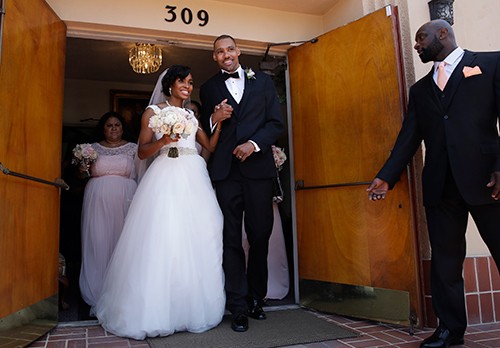
Outside of his ongoing rehab, Nieto is as busy as ever, with a full plate of creative ventures. He has written three sitcom pilots for Harvest, and he continues to dabble in acting, having recently auditioned for the FX series Baskets, starring Zach Galifianakis. “Whether I get it or not, I was happy that I went into the room and just gave a good audition,” says Nieto, who studied acting for about eight years and had a recurring role as a doctor on the Pure Flix drama Hilton Head Hospital.
He has also written his autobiography, The Jamie Nieto Story: Raising the Bar on Life, which he hopes to publish around the time of the 2020 Olympics in Tokyo. “From where I started to where I ended up, I don’t think people would have ever guessed that I would have made it this far,” he says. “I don’t think I would have guessed that I would have made it this far.”
He recently finished a children’s book as well, Mad Hops, the Grasshopper, about a high-jumping insect who fights his way back from an injury to the Bug Olympics. “When I was a little younger, they called me Mad Hops: ‘Man, that guy’s got mad hops, look at him!’” Nieto says. “I wanted it to be something that kids 5 to 8 can enjoy. I would like to turn it into a cartoon one day.”
Three years after the injury, Nieto estimates his recovery is in the “high 70s, if not low 80s.” Moving from the power chair to a walker was very slow, but then he moved from the walker to arm crutches, and from those to a four-pronged cane last December.
“The cane gives me that reassurance that if I get a little bit too far forward on my toes, I’m not going to fall,” he explains. “The neurological injury affects your nerves, and my nerves are telling my feet to be on their toes. And I don’t want to be on my toes. I want to stay relaxed.
“Every time I change to something new, it’s like two steps back to go four steps forward,” he adds. “I’ll only be walking with this cane until I’m not anymore. I’ll only be walking until I’m running. I’ll only be running until I’m jumping. When I’m ready and my body is ready, it’s going to happen.”
Dick Anderson is a freelance writer based in Los Angeles.
Contact Darcy Gifford, dgiffor2@emich.edu , 734.487.5375

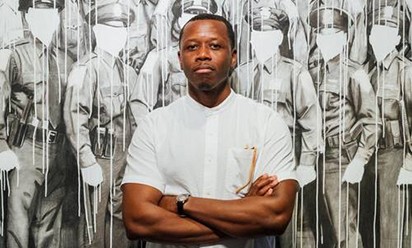 Tylonn Sawyer is striking a chord with his figurative art, in Michigan and beyond.
Tylonn Sawyer is striking a chord with his figurative art, in Michigan and beyond.
 Book research unearths work of former EMU faculty members.
Book research unearths work of former EMU faculty members.
 For EMU alumna Celeste Malvar-Stewart, her farm-to-fashion is more than meets the eye.
For EMU alumna Celeste Malvar-Stewart, her farm-to-fashion is more than meets the eye.